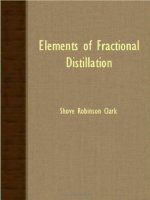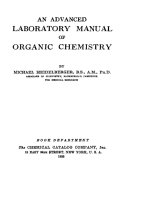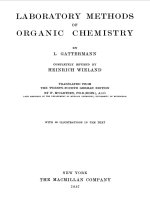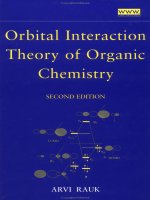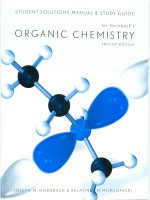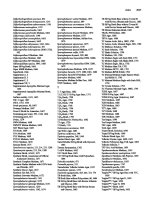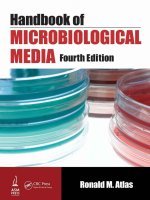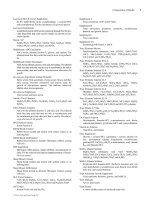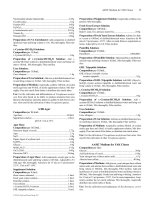Schaums Outline of Organic Chemistry, Fourth Edition (Schaums Outline Series) Herbert Meislich, Howard Nechamkin, Jacob Sharefkin, George Hademenos
Bạn đang xem bản rút gọn của tài liệu. Xem và tải ngay bản đầy đủ của tài liệu tại đây (13.39 MB, 481 trang )
Organic
Chemistry
This page intentionally left blank
Organic
Chemistry
Fourth Edition
Herbert Meislich, Ph.D.
Professor Emeritus of Chemistry, City College of CUNY
Jacob Sharefkin, Ph.D.
Professor Emeritus of Chemistry, Brooklyn College of CUNY
Howard Nechamkin, Ed.D.
Professor Emeritus of Chemistry, Trenton State College
George J. Hademenos, Ph.D.
Former Visiting Assistant Professor, Department of Physics,
University of Dallas
Schaum’s Outline Series
New York Chicago San Francisco Lisbon London Madrid
Mexico City Milan New Delhi San Juan Seoul
Singapore Sydney Toronto
Copyright © 2010, 1999, 1991, 1977 by The McGraw-Hill Companies, Inc. All rights reserved. Except as permitted under the United States Copyright Act of
1976, no part of this publication may be reproduced or distributed in any form or by any means, or stored in a database or retrieval system, without the prior
written permission of the publisher.
ISBN: 978-0-07-162513-5
MHID: 0-07-162513-5
The material in this eBook also appears in the print version of this title: ISBN: 978-0-07-1625128, MHID: 0-07-162512-7.
All trademarks are trademarks of their respective owners. Rather than put a trademark symbol after every occurrence of a trademarked name, we use names in
an editorial fashion only, and to the benefit of the trademark owner, with no intention of infringement of the trademark. Where such designations appear in this
book, they have been printed with initial caps.
McGraw-Hill eBooks are available at special quantity discounts to use as premiums and sales promotions, or for use in corporate training programs. To contact
a representative please e-mail us at
TERMS OF USE
This is a copyrighted work and The McGraw-Hill Companies, Inc. (“McGraw-Hill”) and its licensors reserve all rights in and to the work. Use of this work is
subject to these terms. Except as permitted under the Copyright Act of 1976 and the right to store and retrieve one copy of the work, you may not decompile,
disassemble, reverse engineer, reproduce, modify, create derivative works based upon, transmit, distribute, disseminate, sell, publish or sublicense the work or
any part of it without McGraw-Hill’s prior consent. You may use the work for your own noncommercial and personal use; any other use of the work is strictly
prohibited. Your right to use the work may be terminated if you fail to comply with these terms.
THE WORK IS PROVIDED “AS IS.” McGRAW-HILL AND ITS LICENSORS MAKE NO GUARANTEES OR WARRANTIES AS TO THE ACCURACY,
ADEQUACY OR COMPLETENESS OF OR RESULTS TO BE OBTAINED FROM USING THE WORK, INCLUDING ANY INFORMATION THAT CAN
BE ACCESSED THROUGH THE WORK VIA HYPERLINK OR OTHERWISE, AND EXPRESSLY DISCLAIM ANY WARRANTY, EXPRESS OR
IMPLIED, INCLUDING BUT NOT LIMITED TO IMPLIED WARRANTIES OF MERCHANTABILITY OR FITNESS FOR A PARTICULAR PURPOSE.
McGraw-Hill and its licensors do not warrant or guarantee that the functions contained in the work will meet your requirements or that its operation will be uninterrupted or error free. Neither McGraw-Hill nor its licensors shall be liable to you or anyone else for any inaccuracy, error or omission, regardless of cause, in
the work or for any damages resulting therefrom. McGraw-Hill has no responsibility for the content of any information accessed through the work. Under no
circumstances shall McGraw-Hill and/or its licensors be liable for any indirect, incidental, special, punitive, consequential or similar damages that result from
the use of or inability to use the work, even if any of them has been advised of the possibility of such damages. This limitation of liability shall apply to any
claim or cause whatsoever whether such claim or cause arises in contract, tort or otherwise.
To Amy Nechamkin, Belle D. Sharefkin,
John B. Sharefkin,
Kelly Hademenos, and Alexandra Hademenos
This page intentionally left blank
Preface
The beginning student in Organic Chemistry is often overwhelmed by facts, concepts, and new language. Each
year, textbooks of Organic Chemistry grow in quantity of subject matter and in level of sophistication. This
Schaum’s Outline was undertaken to give a clear view of first-year Organic Chemistry through the careful
detailed solution of illustrative problems. Such problems make up over 80% of the book, the remainder being a
concise presentation of the material. Our goal is for students to learn by thinking and solving problems rather
than by merely being told.
This book can be used in support of a standard text, as a supplement to a good set of lecture notes, as a review
for taking professional examinations, and as a vehicle for self-instruction.
The second edition has been reorganized by combining chapters to emphasize the similarities of functional
groups and reaction types as well as the differences. Thus, polynuclear hydrocarbons are combined with benzene and aromaticity. Nucleophilic aromatic displacement is merged with aromatic substitution. Sulfonic acids
are in the same chapter with carboxylic acids and their derivatives, and carbanion condensations are in a separate new chapter. Sulfur compounds are discussed with their oxygen analogs. This edition has also been brought
up-to-date by including solvent effects, CMR spectroscopy, an elaboration of polymer chemistry, and newer
concepts of stereochemistry, among other material.
HERBERT MEISLICH
HOWARD NECHAMKIN
JACOB SHAREFKIN
GEORGE J. HADEMENOS
vii
This page intentionally left blank
Contents
CHAPTER 1
Structure and Properties of Organic Compounds
1
CHAPTER 2
Bonding and Molecular Structure
13
CHAPTER 3
Chemical Reactivity and Organic Reactions
31
CHAPTER 4
Alkanes
50
CHAPTER 5
Stereochemistry
69
CHAPTER 6
Alkenes
87
CHAPTER 7
Alkyl Halides
118
CHAPTER 8
Alkynes and Dienes
140
CHAPTER 9
Cyclic Hydrocarbons
162
CHAPTER 10 Benzene and Polynuclear Aromatic Compounds
189
CHAPTER 11 Aromatic Substitution; Arenes
205
CHAPTER 12 Spectroscopy and Structure
230
CHAPTER 13 Alcohols and Thiols
256
CHAPTER 14 Ethers, Epoxides, Glycols, and Thioethers
278
CHAPTER 15 Carbonyl Compounds: Aldehydes and Ketones
302
CHAPTER 16 Carboxylic Acids and their Derivatives
331
CHAPTER 17 Carbanion-Enolates and Enols
373
CHAPTER 18 Amines
400
CHAPTER 19 Phenolic Compounds
430
CHAPTER 20 Aromatic Heterocyclic Compounds
448
Index
464
ix
This page intentionally left blank
CHAPTER 1
Structure and
Properties of
Organic Compounds
1.1 Carbon Compounds
Organic chemistry is the study of carbon (C) compounds, all of which have covalent bonds. Carbon atoms can
bond to each other to form open-chain compounds, Fig. 1.1(a), or cyclic (ring) compounds, Fig. 1.1(c). Both
types can also have branches of C atoms, Fig. 1.1(b) and (d). Saturated compounds have C atoms bonded to
each other by single bonds, C— C; unsaturated compounds have C’s joined by multiple bonds. Examples
with double bonds and triple bonds are shown in Fig. 1.1(e). Cyclic compounds having at least one atom in
the ring other than C (a heteroatom) are called heterocyclics, Fig. 1.1(f). The heteroatoms are usually oxygen
(O), nitrogen (N), or sulfur (S).
Problem 1.1 Why are there so many compounds that contain carbon?
Bonds between C’s are covalent and strong, so that C’s can form long chains and rings, both of which may
have branches. C’s can bond to almost every element in the periodic table. Also, the number of isomers increases
as the organic molecules become more complex.
Problem 1.2 Compare and contrast the properties of ionic and covalent compounds.
Ionic compounds are generally inorganic, have high melting and boiling points due to the strong electrostatic forces attracting the oppositely charged ions, are soluble in water and insoluble in organic solvents, are hard
to burn, and involve reactions that are rapid and simple. Also, bonds between like elements are rare, with
isomerism being unusual.
Covalent compounds, on the other hand, are commonly organic; have relatively low melting and boiling
points because of weak intermolecular forces; are soluble in organic solvents and insoluble in water; burn readily and are thus susceptible to oxidation because they are less stable to heat, usually decomposing at temperatures above 700ºC; and involve reactions that are slow and complex, often needing higher temperatures and/
or catalysts, yielding mixtures of products. Also, bonds between carbon atoms are typical, with isomerism
being common.
1
2
CHAPTER 1 Structure and Properties of Organic Compounds
H H H H
H C C C C H
H H H H
n-Butane
unbranched,
open-chain
(a)
H H H
H
H
H C C C H
C
H
H H H
HH H
Isobutane
branched,
open-chain
(b)
H
H
H
C C
H
H
Cyclopropane
unbranched, cyclic
(c)
H
H
C
C
C C
H
H
H
H
Methylcyclopropane
branched, cyclic
(d)
H H
H
H
C
C
H C C H
H C
H
Ethene (Ethylene)
Cyclopentene
have double bonds
(e)
H
H
H C C H
H
C
C
H
H
H
H
C
C
H
O
Ethyne (Acetylene)
has a triple bond
Ethylene oxide
heterocyclic
(f )
Figure 1.1
1.2 Lewis Structural Formulas
Molecular formulas merely include the kinds of atoms and the number of each in a molecule (as C4H10 for
butane). Structural formulas show the arrangement of atoms in a molecule (see Fig. 1.1). When unshared
electrons are included, the latter are called Lewis (electron-dot) structures [see Fig. 1-1(f)]. Covalences of the
common elements—the numbers of covalent bonds they usually form—are given in Table 1.1; these help us to
write Lewis structures. Multicovalent elements such as C, O, and N may have multiple bonds, as shown in
Table 1.2. In condensed structural formulas, all H’s and branched groups are written immediately after the C
atom to which they are attached. Thus, the condensed formula for isobutane [Fig. 1-1(b)] is CH3CH(CH3)2.
Problem 1.3 (a) Are the covalences and group numbers (numbers of valence electrons) of the elements in
Table 1.1 related? (b) Do all the elements in Table 1.1 attain an octet of valence electrons in their bonded states?
(c) Why aren’t Group 1 elements included in Table 1.1?
(a) Yes. For the elements in Groups 4 through 7, Covalence ϭ 8 Ϫ (Group number).
(b) No. The elements in Groups 4 through 7 do attain the octet, but the elements in Groups 2 and 3 have less
than an octet. (The elements in the third and higher periods, such as Si, S, and P, may achieve more than an
octet of valence electrons.)
(c) They form ionic rather than covalent bonds. (The heavier elements in Groups 2 and 3 also form mainly
ionic bonds. In general, as one proceeds down a group in the periodic table, ionic bonding is
preferred.)
Most carbon-containing molecules are three-dimensional. In methane, the bonds of C make equal angles of
109.5º with each other, and each of the four H’s is at a vertex of a regular tetrahedron whose center is occupied
by the C atom. The spatial relationship is indicated as in Fig. 1.2(a) (Newman projection) or in Fig. 1.2(b)
(“wedge” projection). Except for ethene, which is planar, and ethyne, which is linear, the structures in Fig. 1.1
are all three-dimensional.
Organic compounds show a widespread occurrence of isomers, which are compounds having the same molecular formula but different structural formulas, and therefore possessing different properties. This phenomenon
of isomerism is exemplified by isobutane and n-butane [Fig. 1.1(a) and (b)]. The number of isomers increases
as the number of atoms in the organic molecule increases.
3
CHAPTER 1 Structure and Properties of Organic Compounds
TABLE
1.1
Covalences of H and Second-Period Elements in Groups 2 through 7
Group
1
2
3
4
5
6
7
Lewis
Symbol
H.
.Be .
.
. B.
.
. C.
.
..
.N.
.
..
.O.
..
..
.F :
..
Covalence
1
2
3
4
3
2
1
H—Be—H
Beryllium
hydride
H—B—H
|
H
Boron
hydride*
..
H—O—H
..
Water
..
H—F:
..
Hydrogen
fluoride
Compounds
with
H
H—H
Hydrogen
H
..
|
H—C—H H—N—H
|
|
H
H
Methane Ammonia
* Exists as B2H6.
TABLE
1.2
Normal Covalent Bonding
BONDING FOR C
BONDING FOR N
C
C
C
C
..
N
..
N
as in
as in
as in
as in
as in
as in
H
H
Methane
H
H
C C
H C H
H
H
Ethene
(Ethylene)
BONDING FOR O
..
N
as in
..
.O.
as in
..
..
.. .. ..
..
..
..
:O C O : H C C H H N H H .O. N O: :N C H H .O. H .O.
H
Carbon
dioxide
Ethyne
(Acetylene)
Ammonia
Nitrous
acid
Hydrogen
cyanide
..
.O.
as in
H
C
H
Water Formaldehyde
Problem 1.4 Write structural and condensed formulas for (a) three isomers with molecular formula C5H12 and
(b) two isomers with molecular formula C3H6.
(a) Carbon forms four covalent bonds; hydrogen forms one. The carbons can bond to each other in a chain:
or there can be “branches” (shown circled in Fig. 1.3) on the linear backbone (shown in a rectangle).
(b) We can have a double bond or a ring.
4
CHAPTER 1 Structure and Properties of Organic Compounds
Figure 1.2
Figure 1.3
Problem 1.5 Write Lewis structures for (a) hydrazine, N2H4; (b) phosgene, COCl2; and (c) nitrous acid, HNO2.
In general, first bond the multicovalent atoms to each other and then, to achieve their normal covalences,
bond them to the univalent atoms (H, Cl, Br, I, and F). If the number of univalent atoms is insufficient for this
purpose, use multiple bonds or form rings. In their bonded state, the second-period elements (C, N, O, and F)
should have eight (an octet) electrons but not more. Furthermore, the number of electrons shown in the Lewis
structure should equal the sum of all the valence electrons of the individual atoms in the molecule. Each bond
represents a shared pair of electrons.
(a) N needs three covalent bonds, and H needs one. Each N is bonded to the other N and to two H’s.
(b) C is bonded to O and to each Cl. To satisfy the tetravalence of C and the divalence of O, a double bond is
placed between C and O.
(c) The atom with the higher covalence, in this case the N, is usually the more central atom. Therefore, each
O is bonded to the N. The H is bonded to one of the O atoms, and a double bond is placed between the N
and the other O. (Convince yourself that bonding the H to the N would not lead to a viable structure.)
CHAPTER 1 Structure and Properties of Organic Compounds
5
Problem 1.6 Why are none of the following Lewis structures for COCl2 correct?
The total number of valence electrons that must appear in the Lewis structure is 24, from [2 ϫ 7](2Cl’s) ϩ
4(C) ϩ 6(O). Structures (b) and (c) can be rejected because they each show only 22 electrons. Furthermore,
in (b), O has 4 rather than 2 bonds, and in (c), one Cl has 2 bonds. In (a), C and O do not have their normal
covalences. In (d), O has 10 electrons, though it cannot have more than an octet.
Problem 1.7 Use the Lewis-Langmuir octet rule to write Lewis electron-dot structures for: (a) HCN, (b) CO2,
(c) CCl4, and (d) C2H6O.
(a) Attach the H to the C, because C has a higher covalence than N. The normal covalences of N and C are met
with a triple bond. Thus, H—Cϭ
⎯ N: is the correct Lewis structure.
(b) The C is bonded to each O by double bonds to achieve the normal covalences.
(c) Each of the four Cl’s is singly bonded to the tetravalent C to give:
(d) The three multicovalent atoms can be bonded as C—C—O or as C—O—C. If the six H’s are placed so that
C and O acquire their usual covalences of 4 and 2, respectively, we get two correct Lewis structures (isomers):
Problem 1.8 Determine the positive or negative charge, if any, on:
The charge on a species is numerically equal to the total number of valence electrons of the unbonded atoms
minus the total number of electrons shown (as bonds or dots) in the Lewis structure.
(a) The sum of the valence electrons (6 for O, 4 for C, and 3 for three H’s) is 13. The electron-dot formula
shows 14 electrons. The net charge is 13 Ϫ 14 ϭ Ϫ1, and the species is the methoxide anion,
.
6
CHAPTER 1 Structure and Properties of Organic Compounds
(b) There is no charge on the formaldehyde molecule, because the 12 electrons in the structure equals the
number of valence electrons—that is, 6 for O, 4 for C, and 2 for two H’s.
(c) This species is neutral, because there are 13 electrons shown in the formula and 13 valence electrons:
8 from two C’s and 5 from five H’s.
(d) There are 15 valence electrons: 6 from O, 5 from N, and 4 from four H’s. The Lewis dot structure shows
14 electrons. It has a charge of 15 Ϫ 14 ϭ ϩ1 and is the hydroxylammonium cation, [H3NOH]ϩ.
(e) There are 25 valence electrons, 21 from three Cl’s and 4 from C. The Lewis dot formula shows 26 electrons.
It has a charge of 25 Ϫ 26 ϭ Ϫ1 and is the trichloromethide anion, :CCl3–.
1.3 Types of Bonds
Covalent bonds, the mainstays of organic compounds, are formed by the sharing of pairs of electrons. Sharing
can occur in two ways:
(1) A ⋅ + ⋅ B → A : B
(2) A + :B → A : B coordinate covalent
acceptor
donor
In method (1), each atom brings an electron for the sharing. In method (2), the donor atom (B:) brings both
electrons to the “marriage” with the acceptor atom (A); in this case, the covalent bond is termed a coordinate
covalent bond.
Problem 1.9 Each of the following molecules and ions can be thought to arise by coordinate covalent bonding. Write an equation for the formation of each one and indicate the donor and acceptor molecule or ion:
(a) NHϩ4; (b) BF Ϫ4; (c) (CH3)2OMgCl2; and (d) Fe(CO)5.
(a)
(b)
(c)
(d)
Notice that in each of the products there is at least one element that does not have its usual covalence—this is
typical of coordinate covalent bonding.
Recall that an ionic bond results from a transfer of electrons (M· ϩ A·
Mϩ ϩ :AϪ). Although C usually
forms covalent bonds, it sometimes forms an ionic bond (see Section 3.2). Other organic ions, such as CH3COOϪ
(acetate ion), have charges on heteroatoms.
Problem 1.10
Show how the ionic compound LiϩF Ϫ forms from atoms of Li and F.
These elements react to achieve a stable noble-gas electron configuration (NGEC). Li(3) has one electron
more than He and loses it. F(9) has one electron less than Ne and therefore accepts the electron from Li.
1.4 Functional Groups
Hydrocarbons contain only C and hydrogen (H). H’s in hydrocarbons can be replaced by other atoms or groups
of atoms. These replacements, called functional groups, are the reactive sites in molecules. The C-to-C double and
triple bonds are considered to be functional groups. Some common functional groups are given in Table 1.3.
CHAPTER 1 Structure and Properties of Organic Compounds
7
Compounds with the same functional group form a homologous series having similar characteristic chemical
properties and often exhibiting a regular gradation in physical properties with increasing molecular weight.
Problem 1.11 Methane, CH4; ethane, C2H6; and propane, C3H8, are the first three members of the alkane
homologous series. By what structural unit does each member differ from its predecessor?
These members differ by a C and two H’s; the unit is —CH2— (a methylene group).
Problem 1.12 (a) Write possible Lewis structural formulas for (1) CH4O; (2) CH2O; (3) CH2O2; (4) CH5N;
and (5) CH3SH. (b) Indicate and name the functional group in each case.
The atom with the higher valence is usually the one to which most of the other atoms are bonded.
(a)
(b)
1.5 Formal Charge
The formal charge on a covalently bonded atom equals the number of valence electrons of the unbonded atom (the
group number) minus the number of electrons assigned to the atom in its bonded state. The assigned number is
one half the number of shared electrons plus the total number of unshared electrons. The sum of all formal charges
in a molecule equals the charge on the species. In this outline, formal charges and actual ionic charges (e.g., Naϩ)
are both indicated by the signs ϩ and Ϫ.
Problem 1.13 Determine the formal charge on each atom in the following species: (a) H3NBF3; (b) CH3NHϩ3;
and (c) SO 42Ϫ.
(a)
The sum of all formal charges equals the charge on the species. In this case, the ϩ1 on N and the Ϫ1 on
B cancel
(b)
8
CHAPTER 1 Structure and Properties of Organic Compounds
and the species is an unchanged molecule:
(c)
These examples reveal that formal charges appear on an atom that does not have its usual covalence and does
not have more than an octet of valence electrons. Formal charges always occur in a molecule or ion that can be
conceived to be formed as a result of coordinate covalent bonding.
Problem 1.14 Show how (a) H3NBF3 and (b) CH3NH ϩ3 can be formed from coordinate covalent bonding. Indicate the donor and acceptor, and show the formal charges.
(a)
(b)
SUPPLEMENTARY PROBLEMS
Problem 1.15
Why are the compounds of carbon covalent rather than ionic?
With four valence electrons, it would take too much energy for C to give up or accept four electrons. Therefore, carbon shares electrons and forms covalent bonds.
Problem 1.16 Classify the following as (i) branched chain, (ii) unbranched chain, (iii) cyclic, (iv) multiple
bonded, or (v) heterocyclic:
(a) (iii) and (iv); (b) (i); (c) (ii); (d) (v); (e) (iv) and (ii).
CHAPTER 1 Structure and Properties of Organic Compounds
Some Common Functional Groups
1.3
TABLE
9
TABLE
1.3
(continued)
10
The italicized portion indicates the group.
A primary (1º) amine; there are also secondary (2º) R2NH, and tertiary (3º) R3N amines.
3 Another name is propanamine.
2
CHAPTER 1 Structure and Properties of Organic Compounds
1
CHAPTER 1 Structure and Properties of Organic Compounds
11
Problem 1.17 Refer to a periodic chart and predict the covalences of the following in their hydrogen
compounds: (a) O; (b) S; (c) Cl; (d ) C; (e) Si; ( f ) P; (g) Ge; (h) Br; (i) N; (j) Se.
The number of covalent bonds typically formed by an element is 8 minus the group number. Thus: (a) 2;
(b) 2; (c) 1; (d) 4; (e) 4; (f) 3; (g) 4; (h) 1; (i) 3; ( j) 2.
Problem 1.18
Which of the following are isomers of 2-hexene, CH3CHϭCHCH2CH2CH3?
(a) CH3CH2 CHϭCHCH2CH3
(c) CH3 CH2CH2CHϭCHCH3
(b) CH2ϭCHCH2CH2 CH2CH3
All but (c), which is 2-hexene itself.
Problem 1.19
Find the formal charge on each element of
and the net charge on the species (BF3Ar).
Problem 1.20 Write Lewis structures for the nine isomers having the molecular formula C3H6O, in which C,
H, and O have their usual covalences; name the functional group(s) present in each isomer.
One cannot predict the number of isomers by mere inspection of the molecular formula. A logical method
runs as follows. First write the different bonding skeletons for the multivalent atoms, in this case the three C’s
and the O. There are three such skeletons:
To attain the covalences of 4 for C and 2 for O, eight H’s are needed. Since the molecular formula has only six
H’s, a double bond or ring must be introduced onto the skeleton. In (i), the double bond can be situated three
ways, between either pair of C’s or between the C and O. If the H’s are then added, we get three isomers: (1),
(2), and (3). In (ii), a double bond can be placed only between adjacent C’s to give (4). In (iii), a double bond
can be placed between a pair of C’s or C and O, giving (5) and (6), respectively.
12
CHAPTER 1 Structure and Properties of Organic Compounds
In addition, three ring compounds are possible:
CHAPTER
CHAPTER
2 2
Bonding and
Molecular
Structure
2.1 Atomic Orbitals
An atomic orbital (AO) is a region of space about the nucleus in which there is a high probability of finding
an electron. An electron has a given energy, as designated by (a) the principal energy level (quantum number) n, related to the size of the orbital; (b) the sublevel s, p, d, f, or g, related to the shape of the orbital; (c)
except for the s, each sublevel having some number of equal-energy (degenerate) orbitals differing in their
spatial orientation; and, (d) the electron spin, designated ↑ or ↓. Table 2.1 shows the distribution and designation of orbitals.
TABLE
2.1
Principal energy level, n
1
2
3
4
Maximum no. of electrons, 2n2
2
8
18
32
Sublevels [n in number]
1s
2s, 2p
3s, 3p, 3d
4s, 4p, 4d, 4f
Maximum electrons per sublevel
2
2, 6
2, 6, 10
2, 6, 10, 14
Designations of filled orbitals
1s2
2s2, 2p6
3s2, 3p6, 3d10
4s2, 4p6, 4d10, 4f 14
Orbitals per sublevel
1
1, 3
1, 3, 5
1, 3, 5, 7
13
14
CHAPTER 2 Bonding and Molecular Structure
The s orbital is a sphere around the nucleus, as shown in cross section in Fig. 2.1(a). A p orbital is two
spherical lobes touching on opposite sides of the nucleus. The three p orbitals are labeled px, py, and pz because
they are oriented along the x-, y-, and z-axes, respectively [Fig. 2.1(b)]. In a p orbital, there is no chance of finding an electron at the nucleus—the nucleus is called a node point. Regions of an orbital separated by a node are
assigned ϩ and Ϫ signs. These signs are not associated with electrical or ionic charges. The s orbital has no
node and is usually assigned a ϩ.
Figure 2.1
Three principles are used to distribute electrons in orbitals:
1. “Aufbau” or building-up principle. Orbitals are filled in order of increasing energy: 1s, 2s, 2p, 3s, 3p, 4s,
3d, 4p, 5s, 4d, 5p, 6s, 4f, 5d, 6p, and so on.
2. Pauli exclusion principle. No more than two electrons can occupy an orbital and then only if they have
opposite spins.
3. Hund’s rule. One electron is placed in each equal-energy orbital so that the electrons have parallel spins,
before pairing occurs. (Substances with unpaired electrons are paramagnetic—they are attracted to a
magnetic field.)
Problem 2.1 Show the distribution of electrons in the atomic orbitals of (a) carbon and (b) oxygen.
A dash represents an orbital; a horizontal space between dashes indicates an energy difference. Energy
increases from left to right.
(a) Atomic number of C is 6.
↑↓↑↓ ↑ ↑
1s 2s 2 px 2 py 2 pz
The two 2p electrons are unpaired in each of two p orbitals (Hund’s rule).
(b) Atomic number of O is 8.
↑↓↑↓ ↑↓ ↑ ↑
1s 2s 2 px 2 py 2 pz
2.2 Covalent Bond Formation—Molecular Orbital (MO) Method
A covalent bond forms by overlap (fusion) of two AO’s—one from each atom. This overlap produces a
new orbital, called a molecular orbital (MO), which embraces both atoms. The interaction of two AO’s can
produce two kinds of MO’s. If orbitals with like signs overlap, a bonding MO results which has a high
